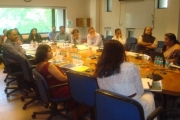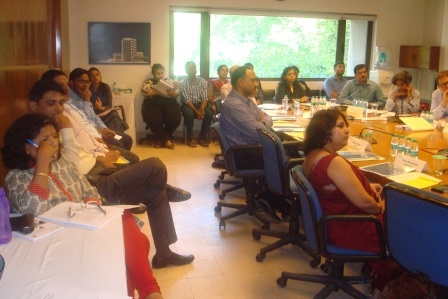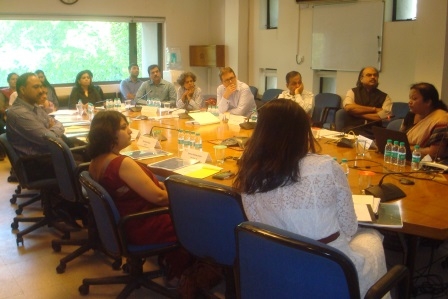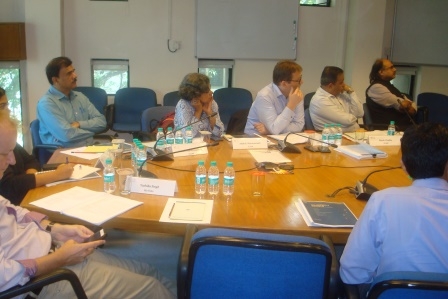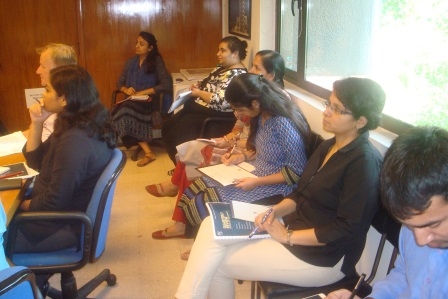NCAER’S Quarterly Review of the Economy July 2016
NCAER predicts GDP will grow at 7.6 percent in 2016-17
NCAER Team presented the Quarterly Review of the Economy at a seminar held at its Conference Room. The review covered the performance of the Economy in the first quarter of 2016-17 and forecast for the year head. The seminar also included a presentation by Andreas Bauer, Senior Resident Representative—India, Nepal, Bhutan on ‘’Global Outlook and the Brexit Impact.
Key Highlights
NCAER’s annual model for GDP market prices at constant (2011–12) prices forecasts a GDP growth rate of 7.6% for 2016-17. The Gross Value Added (GVA) at Basic Prices at constant (2011-12) prices is predicted to grow at 7.2% in 2016-17. Real Agriculture GVA is forecasted to grow at 4.1%, real Industry GVA at 7.1% and real Services GVA at 7.9% in 2016-17. Growth in exports and imports, in dollar terms, is projected at 2.5% and (-) 8.0%, respectively, while Wholesale Price Index (WPI) inflation is projected at 2.8% for 2016-17. The current account balance and fiscal deficit as percentage of GDP are projected at (-) 0.7% and 3.1%, respectively, for 2016-17.
In the agriculture sector, a redeeming feature of 2015-16 was that despite deficiency in monsoon rainfall the overall output of food grains did not fall though output of commercial crops did suffer. During 2016-17 the South-west monsoon was deficient in June 2016 but in July 2016 there was a significant recovery though it still continues to remain spatially uneven as a quarter of the 36 sub-districts in India are still suffering from deficiency in rainfall. Though outlook for the second half of the monsoon season remains positive, which probably would dampen the price rise in 2016-17, which otherwise have witnessed a significant jump in the first quarter of this financial year.
On the industrial sector front, the Index of Industrial Production (IIP) numbers show weak growth for the first two months of the current fiscal. For April-May, 2016-17, it grew at -0.1 per cent on a year-on-year (y-o-y) basis, mainly driven down by slow and uneven growth in manufacturing (-1.5%). Capital goods suffered double-digit fall in the first two months of the current fiscal indicating weak investment activity in the economy (-18.9%) on a y-0-y basis. Consumer durables growth continues to exhibit strong growth (8.9% on a y-o-y basis). The index of eight core industries grew by 5.4% in 2016-17:Q1 versus 2.5% in 2015-16:Q1.
The lead indicators of the services sector suggest an uncertain outlook for the first quarter of the current fiscal. Tourist arrivals grew by 7.4% on a y-o-y basis during 2016-17:Q1, versus 3.7% in 2015-16:Q1. Bank Credit to the Commercial Sector stagnated at 8.8% and 8.9% in 2015-16:Q1 and 2016-17:Q1 respectively. However, y-o-y growth of aggregate deposits slowed down to 9.1% in 2016-17:Q1 versus 10.6% in 2015-16:Q1. Other lead indicators also showed mixed y-o-y growth patterns except domestic aviation passenger traffic (20.4%) and production of commercial vehicles (17.3%). Both showed double digit growth in 2016-17:Q1
The performance of the external sector in the first quarter has been relatively weak but it shows signs of improvements. The first quarter (Q1: April-June) of 2016-17 has posted a decline of 2.1% (y-o-y) in merchandise exports to US$ 65.3 billion. Imports declined by 14.5% (y-o-y) to US$ 84.5 billion. The slowdown in imports was mainly due to reduction in oil imports that reduced by 23.6% (y-o-y) in 2016-17:Q1. Non-oil imports declined by 11.5% (y-o-y) in 2016-17:Q1. Service exports and imports also showed signs of improvement. After growing negatively on a y-o-y basis from November 2015, exports grew at 13.4% and imports at 25.4% in May 2016.
The BSE Sensex moved up by more than 1500 points in Q1, from 25,343 on March 31, 2016 to 27,000 on June 30, 2016. However, the y-o-y percentage rate of growth continues to be negative in 2016-17:Q1 (-4.1%).
On the prices front, y-o-y WPI inflation further edged upwards, turning positive (1.1%) in 2016-17:Q1. CPI inflation (y-o-y) also turned marginally upwards (5.7%). This is mainly due to the jump in food inflation. WPI Food Articles inflation (y-o-y) increased from 4.8% in 2015-16:Q1 to 6.9% in 2016-17:Q1. Consumer Food Price Index showed y-o-y increase of 7.2% in 2016-17:Q1, from 5.8% in 2015-16:Q4. Food inflation was mainly driven by double-digit inflation of pulses (32.3%) and vegetables (10.9%). Within vegetables, it was potatoes that was the driving force, rising by 55.5% in 2016-17:Q1 versus -6.7% in 2015-16:Q1. Core-WPI (y-o-y) inflation rate, however remained at sub-zero level in 2016-17:Q1 but shows increasing trend from September 2015. Core CPI (y-o-y) inflation rate fluctuated around 4.6 between the period April 2015 to June 2016.
On the fiscal front, the deficit touched 61% of the budget estimate in 2016-17:Q1, as against 51.2% in 2015-16:Q1.
About the Quarterly Review of the Economy
The Quarterly Review has been designed to meet the needs of policy makers, corporates and others interested in tracking the latest developments in the Indian economy. It provides an analysis of current policies and tracks developments in both the domestic as well as the global economies. The growth forecasts of NCAER are objective and are widely quoted and referred to in both the Indian as well as the international media. An integral part of the Quarterly Review is the State of Economy Seminars, organised quarterly at NCAER, which bring together policy makers, industry leaders and researchers at one forum.






